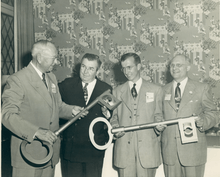Speed nut
A speed nut, aka sheet metal nut or Tinnerman nut, is a type of locknut with two sheet metal prongs that act as one thread. They are made from spring steel.

The fastener serves the functions of both a lock washer and a nut. As the fastener is tightened in the nut the prongs are drawn inward until they exert pressure on the root of the thread on the fastener. When the fastener is tightened, the base of the nut, which is arched, elastically deforms and applies a force to the fastener, which locks it from loosening under vibrations.[1]
There are many different types of speed nuts, mostly dependent on the shape of the nut, how it attaches to the workpiece, and what type of screw can be used. Most types are designed for either machine screws or sheet metal screws. Some nuts do not attach to the workpiece. These are usually shaped as either a rectangle, a flange nut, or a hex nut; the rectangular speed nut is also known as a flat-style speed nut. Speed nuts that attach to the workpiece usually are some form of a J-nut or U-nut.[2][3]
History
The speed nut was invented in 1924 by Albert H. Tinnerman, son of prominent Cleveland stove pioneer and banker, George Tinnerman, who started Tinnerman Steel Range Company and developed and manufactured the first sheet metal kitchen range in 1875. This was a vast improvement over cast iron stoves of that day. In 1923, Albert H. Tinnerman originated the first all-porcelain enameled gas range with concealed fastenings. Tinnerman invented the speed nut to resolve issues with stove shipping. George Tinnerman II, grandson of the founder, commercialized Speed Nuts in markets beyond stoves. So successful in fact that the stove business shut down entirely. He held over 400 fastener patents. Tinnerman became the supplier of fasteners for 100% of WWII aircraft. According to a 1947 Fortune Magazine article, the Tinnerman Company used aggressive techniques to change the automotive industry. The timesaving fasteners held parts in place without the need for welding or riveting. At the time, an automobile manufacturer doubted that it was strong enough to hold fenders to bodies. A.H. Tinnerman responded by hoisting a 3,325-pound Plymouth off the ground supported by a Speed Nut. A.H. also created a plan to save Ford millions of dollars by changing the way automobiles are created – finding 400 unique places and application for Tinnerman products. It became an automotive revolution.
[4] Tinnerman Products was formed in 1939, and evolved from the Speed Nut development with manufacturing plants in Cleveland, Ohio. A modern manufacturing plant was constructed on Brookpark Road in the early 1950s. Tinnerman Products later merged with Eaton Yale & Towne in 1969. (Eaton Corporation). In 1999, Eaton sold Tinnerman to TransTechnology for $173 million cash. In 2009, ARaymond purchased Tinnerman for an undisclosed sum. ARaymond Tinnerman has manufacturing facilities in Brunswick, OH; Rochester Hills, Mich.; Flemingsburg, Ky.; Logansport, Ind.; Hamilton, Ontario; and San Luis Potosí, Mexico.
See also
References
Notes
- Smith, p. 115.
- McMaster, p. 3148.
- McMaster, p. 3149.
- History, archived from the original on 2010-01-26, retrieved 2010-01-25.
Bibliography
- McMaster-Carr catalog (114th ed.), McMaster-Carr.
- Smith, Carroll (1990), Carroll Smith's Nuts, Bolts, Fasteners, and Plumbing Handbook, MotorBooks/MBI Publishing Company, ISBN 0-87938-406-9.
- https://clevelandhistorical.org/items/show/566 Retrieved September 10, 2019
- Ganson Rose, William, (1990), Cleveland, the Making of a City [1]
- http://www.eaton.com/Eaton/OurCompany/NewsEvents/NewsReleases/98065990 Retrieved September 10, 2019
- https://www.cleveland.com/business/2009/11/french_competitor_a_raymond_bu.html Retrieved September 10, 2019
- https://www.araymond-automotive.com/en/presence-in-the-world Retrieved September 10, 2019
- Plain Dealer Publishing Co, (1906), Progressive Men of Northern Ohio https://books.google.com/books?id=9NYyAQAAMAAJ&pg=PA26
- R. Coates, William, (1924), A History of Cuyahoga County and the City of Cleveland
- Survey of Buying Power (1951) - Volume 67 - Page 146
- https://www.riversidecemeterycleveland.org/rs_hs_g.htm#tinnerman
- Scott Downs, Winfield (1941). Encyclopedia of American biography.[2]
- http://www.araymondtinnerman.com/industrial/resources/Catalog-Final_10.29-w-Revisions.pdf
- Ganson Rose, William (1990). Cleveland: The Making of a City. Kent, Ohio: Kent State Univ Pr; 19th Revised ed. edition. p. 819. ISBN 0873384288.
- Scott Downs, Winfield (1941). Encyclopedia of American biography: New series. American Historical Company. p. 165.